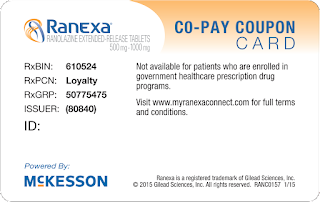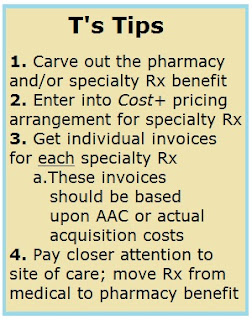Amgen, AbbVie ‘ahead of the crowd’ in fighting payers’ latest assault on copay coupons
 |
| Copay Coupon Sample |
 |
| Copay Coupon Sample |
Always include a semi-annual market check in your PBM contract language. Market checks provide each payer the ability, during the contract, to determine if better pricing is available in the marketplace compared to what the client is currently receiving.
When better pricing is discovered the contract language should stipulate the client be indemnified. Do not allow the PBM to limit the market check language to a similar size client, benefit design and/or drug utilization. In this case, the market check language is effectually meaningless.
 |
| Click to Learn More |
With much fanfare, President Donald Trump’s administration recently released a 44-page blueprint for executive action on drug pricing titled American Patients First. The blueprint proposes steps to end drug manufacturers’ “gaming” of the regulatory process and to create incentives for pharmaceutical companies to lower list prices. The proposals regarding pharmacy benefit manager (PBM) firms, in particular, could affect drug costs covered by employer-sponsored group health plans.
The blueprint, however, also asks whether PBMs should be obligated to act solely in the interest of those for whom they manage drug benefits. If PBMs were identified as plan fiduciaries, they would be accountable for negotiating in the best interest of the plan and its members. This could certainly change the dynamics of current PBM relationships and, if adopted, keep PBMs from accepting certain types of payments from manufacturers that favor coverage of higher-cost drugs.
Tyrone’s Commentary:
For all intents and purposes, there are only two types of PBM business models; non-fiduciary and fiduciary. Don’t be fooled by labels such as pass-through, transparent, limited fiduciary (a new one) or others. I’m often asked what’s the difference between a transparent and fiduciary PBM. Here is the big difference. A fiduciary PBM is required to act in its clients’ best interest first for every action it takes on behalf of that client. In other words, the fiduciary PBM is contractually obligated to contain its clients cost. Any other PBM model regardless of what they tell you is not contractually obligated to contain costs. They are intentionally trying to avoid this responsibility so don’t let them off the hook!
Always include a semi-annual market check in your PBM contract language. Market checks provide each payer the ability, during the contract, to determine if better pricing is available in the marketplace compared to what the client is currently receiving.
When better pricing is discovered the contract language should stipulate the client be indemnified. Do not allow the PBM to limit the market check language to a similar size client, benefit design and/or drug utilization. In this case, the market check language is effectually meaningless.
 |
| Click to Learn More |
An appellate court has determined OptumRx’s bid did not conform to the bid solicitation, because it included language reserving the right to modify the financial terms of the deal to protect its profit if the state made changes to the plan design.
“Optum’s additional language … permitted it to ‘hedge’ its bid, thereby reducing its financial risk from adverse plan design changes,” the court said. “That set it apart from the other bidders who agreed to be bound by all of the terms of the bid solicitation.”
Tyrone’s Commentary:
I here it all the time from purchasers of PBM services; control the formulary, go for low net cost, not high rebates, work with a transparent PBM, or make sure the consulting firm isn’t being comped. Everyone knows these things are important, but the execution is usually poor. Furthermore, if the self-insured employer and its consultant aren’t informed or highly sophisticated it can lead to bad contract language that isn’t consistent with bid responses or permits the PBM to modify terms during the contract’s life, for instance. There are three parts to being an adept steward of a pharmacy benefit and they are not mutually exclusive. In other words, if you’re poor in any one of these areas it will hurt you in the other two.
1) Education. If only I had a nickle every time a consultant or HR executive said I don’t need any PBM education. That’s like LeBron James saying I don’t need to practice playing basketball. He’s the best in the world yet he still studies the game more than any other player! You may attend a webinar or two, read a blog post or chat with peers and I can tell you it still isn’t enough to beat non-fiduciary PBMs at their own game. Invest more time and money into becoming a better steward of pharmacy benefits. Incrementalism in this area will not be rewarded. The best proponent of transparency is informed and sophisticated purchasers of PBM services.
2) Procurement. Means the action of obtaining or procuring something. When obtaining PBM services, ideally it involves a reverse auction. The state of New Jersey ran a reverse auction but somehow Optum’s bid still squeeked through. My guess is that human interference got in the way, as it often does, with the real bid winner or the reverse auction was inherently flawed. Because one takes action on a problem doesn’t guarantee an optimal outcome. You can swing (act) at a 95 mph fastball but will miss (outcome) 99 out of a 100 times unless of course you’re a well-trained professional and student of the game. There are a lot of companies and consultants that procure PBM services who are missing a lot! One problem is a lack of accountability unlike standing in the batters box alone. It would be nice if self-insured employers had a stopgap like an appellate court to fall back on. Oh wait they do and they’re called benefits consultants.
3) Vigorous Oversight. PBM performance should be monitored on an ongoing basis far beyond standard reports. The types of routine monitoring activities performed by the plan sponsor can vary based on past performance with the PBM or the nature of the services performed. The type and frequency of monitoring should be documented in the contract before it is executed. The plan sponsor should establish key performance metrics designed to measure PBM services. The PBM oversight program must also define what happens if the vendor’s performance is below the plan sponsor’s performance expectations. When noncompliant performance occurs, the plan sponsor should request a formal action plan defining specific activities to ensure performance meets the defined expectations.
The state, meanwhile, argued Optum’s language was meaningless and didn’t affect the outcome of the auction. The three-person court invalidated the contract, saying its size, complexity and potential savings for the public aren’t a shield from this type of review.
“No savings can justify the impairment to the integrity of the bidding process caused by an irregular proceeding, the court said.
Amgen’s Repatha and Sanofi and Regeneron’s Praluent were approved in 2015 with blockbuster expectations. But the number of patients with high cholesterol and the $14,000 a year price tag of the drugs prompted heavy restrictions from PBMs.
In an attempt to juice sales, Sanofi and Regeneron substantially cut their drug’s net price for Express Scripts so it would reduce those restrictions. Back-slapping followed. But this is just a louder and bigger version of something that happens all of the time: an exchange of a bigger rebate for more favorable coverage.
Tyrone’s Commentary:
At first glance the drop in price appears to be a positive move and it could very well turn out that way. However, self-funded employers have to keep a keen eye on utilization. Express Scripts will remove almost all restrictions on the medicine and make it cheaper for patients, for instance. Plan sponsors need to understand the manufacturer-side revenue ESI is generating for itself and its affect on final plan cost. Furthermore, consider implementing your own step therapy or PA processes. Robust oversight on PBM performance is standing operating procedure, but especially important for expensive medications.
If demand increases, Express Scripts benefits from a handsome rebate, and rising drug costs will largely flow through to clients. The list price is staying the same, and the majority of consumers will still be exposed. A few more patients will get Praluent, which is a genuinely good thing. And a pantomime of a dialogue about lower list prices is better than nothing. But at the end of the day, nothing really changes.
Always include a semi-annual market check in your PBM contract language. Market checks provide each payer the ability, during the contract, to determine if better pricing is available in the marketplace compared to what the client is currently receiving.
When better pricing is discovered the contract language should stipulate the client be indemnified. Do not allow the PBM to limit the market check language to a similar size client, benefit design and/or drug utilization. In this case, the market check language is effectually meaningless.
 |
| Click to Learn More |
Mark Merritt, president and chief executive officer of the Pharmaceutical Care Management Association, will step aside at the end of the year, after 15 years on the job, the trade group announced Monday morning. The news of Merritt’s departure comes as pharmacy benefit managers (PBM), which PCMA represents, feel increasing pressure from the government and private industry alike.
Always include a semi-annual market check in your PBM contract language. Market checks provide each payer the ability, during the contract, to determine if better pricing is available in the marketplace compared to what the client is currently receiving.
When better pricing is discovered the contract language should stipulate the client be indemnified. Do not allow the PBM to limit the market check language to a similar size client, benefit design and/or drug utilization. In this case, the market check language is effectually meaningless.
 Drugmakers Regeneron and Sanofi are cutting the price they charge pharmacy benefit manager Express Scripts for their cholesterol medicine, Praluent. In return, Express Scripts will remove almost all restrictions on the medicine, and make it cheaper for patients. In theory, that should mean a sales boost.
Drugmakers Regeneron and Sanofi are cutting the price they charge pharmacy benefit manager Express Scripts for their cholesterol medicine, Praluent. In return, Express Scripts will remove almost all restrictions on the medicine, and make it cheaper for patients. In theory, that should mean a sales boost.
“I really hope this works because otherwise it’s a bad message for everyone going forward,” says Steve Miller, Express Scripts’ chief medical officer. Why? Miller says that Praluent was hurt by a high price (list: $14,000 a year), and a lack of proof that it helped patients. But now, Miller says, things have changed.
1) Reads as if ESI is rubberstamping the PA (prior auth) for a drug with a list price of more than $8,000.
2) Plan sponsors need to understand the manufacturer-side revenue ESI is generating for itself and its affect on your final plan cost!
3) The drug appears to be cost-effective even at the high price tag, but make sure not to be wasteful in your spending
4) Plan sponsors may want to consider implementing their own step therapy and PA processes or excluding the drug all together except for extreme cases
New data presented in March seems to indicate that Praluent not only prevents heart attacks, but may save lives. And Regeneron and Sanofi opened themselves up to an independent analysis, by the Institute For Clinical and Economic Review, that showed the medicine was cost-effective at a price below $8,000 for high risk patients. Now they’ve cut the price.